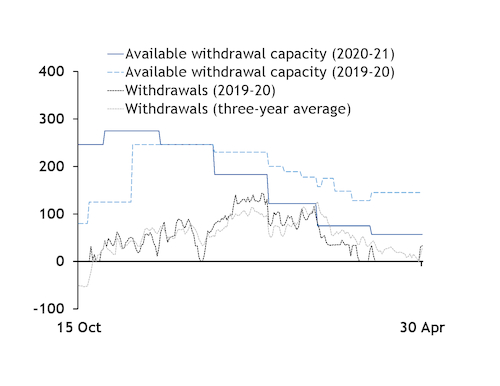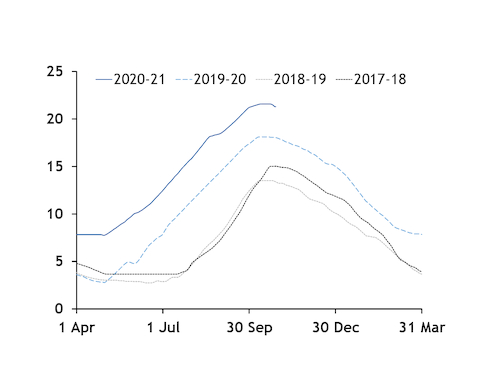Withdrawal capacity at Latvia's Incukalns' gas storage site will fall considerably on the year in January-April, which could restrict withdrawals during periods of peak demand.
Scheduled available capacity in November and December would allow for withdrawals to rise significantly from recent years. But a sharp drop in capacity in the following months could restrict withdrawals relative to daily highs in recent years (see withdrawal capacity graph).
Available withdrawal capacity is expected to step down steadily, falling to just 57 GWh/d in April from 275 GWh/d in November. Average available capacity of 109 GWh/d in January-April is down from 178 GWh/d a year earlier.
This would be more than enough to allow for withdrawals to match the 59.7 GWh/d in January-April this year and 64.4 GWh/d in the previous three years. But it would cap withdrawals well below the high of 243GWh on 30 January 2012 — the quickest since at least 2011. Withdrawals have slid considerably since then, along with a decline in the site's use, and peaked in the past five winters at just 158GWh on 26 February 2018. But this still would be above the 122 GWh/d scheduled to be available in February 2021.
Withdrawal capacity is expected to fall despite the site holding considerably more gas than a year earlier. Stocks were 21.3TWh yesterday morning, well up from the 18TWh a year earlier and higher than at any point since the fourth quarter of 2014 (see stocks graph).
The operator increased the site's working gas capacity for the 2020-21 storage year to 21.53TWh — with all capacity booked — from 18.54TWh in 2019-20. Incukalns' pressure is influenced by factors such as the site's injection regime and operational regime in previous seasons, operator Conexus Baltic Grid has said.
Years of underutilisation presented challenges to the site's physical integrity and prevented a quick ramp-up as storage demand climbed. The site was last filled to nameplate capacity of 24.2TWh in 2014.
Aquifer facilities such as Incukalns need gas injections to maintain capacity and keep water from encroaching on the reservoir. But it may be possible to fully restore the site's storage and injection capacity by using injections to gradually displace water.
The operator reduced Incukalns' working gas capacity last storage year to 18.54TWh, along with a curtailment in injection capacity. But working capacity is to rise to 22.5TWh for the 2021-22 storage year.
The site is the only underground storage facility in the region.




